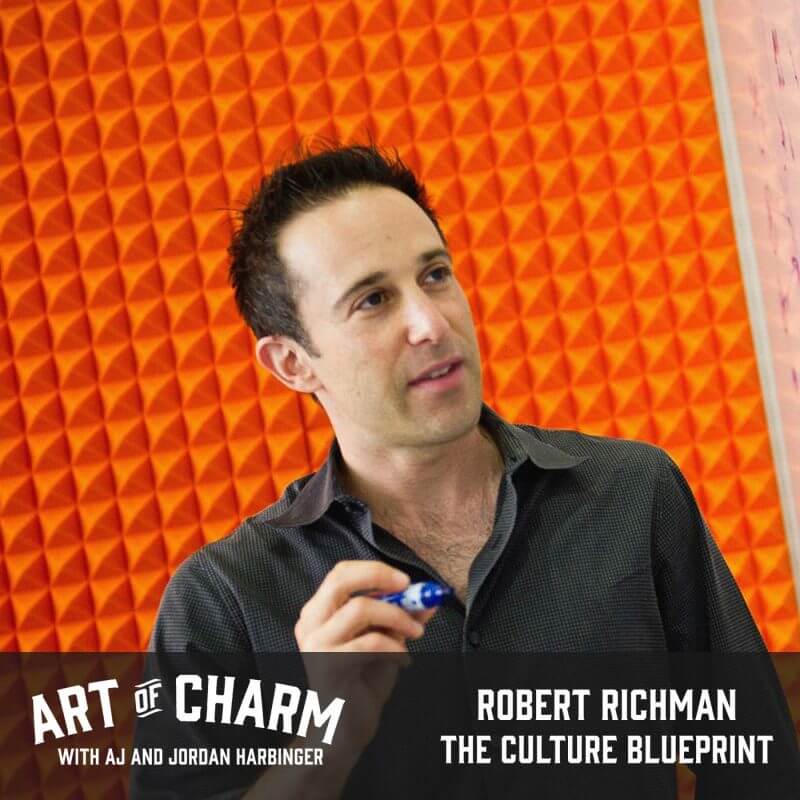Corporate culture is only as boring and stagnant — or exciting and thriving — as the people who create it.
“You can never really create culture…but you can design all these elements around it the same way you can design a house for the kind of interactions you want to have.” -Robert Richman
The Cheat Sheet:
- What is a culture architect? (03:53)
- Why should you care about corporate culture — even if you don’t own or work for a company? (08:10)
- How can hacker philosophy be adopted by people who feel powerless to change their existing culture? (14:35)
- Leaders and workers take note: a self-organizing workforce can be the most efficient, maximized workforce. (24:09)
- How do we develop relevance? (25:42)
- And so much more…
[aoc-subscribe]
Want to learn to think like a hacker, how a workplace can help people grow (while inspiring amazing service and ultimately driving revenue through a thriving culture), how you can create a great company culture (even if it’s not your company), and why you should persevere even if you don’t think you’re qualified to do something?
In this bonus episode of The Art of Charm, we talk to Robert Richman, a corporate culture architect, keynote speaker, author of The Culture Blueprint (available to you for free here), and host of Culture Hackers. If he sounds like a man of many hats, you might be surprised to know that he’s also walked in the shoes of a culture strategist at Zappos. He’s covered head to toe in experience, and we’re happy to have him here to share some of it with us!
More About This Show
A satisfied workforce is more likely to be a workforce that drives prosperity, and Zappos looks to be a textbook example of this philosophy — thanks to the efforts of culture strategist Robert Richman.
And while the tour guide at Zappos headquarters in Las Vegas may not know Robert Richman by name, they likely thank the architect of the company’s world-famous corporate culture every day. Were it not for his innovations, the way the online shoe sales giant conducts its business in house might just be another average blip on the radar of anyone who pays attention to that sort of thing. Now, the company is the envy of many and its practices are a template for others who seek its success through imitation (the sincerest form of flattery, after all).
Luckily for these other businesses, Zappos doesn’t hoard its strategy. It chooses, instead, to share its corporate culture with the world through Zappos Insights, which Robert built from a small website to a thriving multi-million dollar business teaching over 25,000 students per year. Through his work, Robert has been helpful for improving the employee culture at hundreds of companies like Google, Toyota, Eli Lilly, and Inuit.
In his book The Culture Blueprint, Robert’s message is that you may not be able to create a culture within a corporation, but you can design elements around the people within that cultural environment to guide them toward building the culture in an intended direction.
Once the word started getting out about Zappos corporate culture, it was hard to keep under wraps — even if the company had for some reason been inclined to do so. The opportunity to expand Zappos Insights was driven purely by demand.
“Like anything good, it started very organically,” says Robert. “Because Zappos was just giving tours to vendors, and vendors would say, ‘God, this is amazing here. Can we bring our friends?’ And then they started bringing friends to the point that thousands of people were coming through and saying, ‘Hey, can we meet with HR? Can we talk to your training group?’ And so Tony [Hsieh, Zappo’s CEO] said, ‘Wait a minute. We’ve got to do something here! This is clearly a need.’ And one that turned into business.”
“His first idea was to just do a subscription site of videos, and that’s what I got called in to do. And when we ran our first event, we taped it and it was kind of like Romper Room. We really didn’t know what we were doing, but we just brought people in and got them interacting with the culture and with Tony and asking questions and having a fun time. We took them out and partied with them. It was just great.”
“And at the end, for feedback, I asked, ‘Okay. How was the content?’ Because we needed to videotape this and get it on the Web and sell it and…they said it was okay. And I couldn’t believe it was just okay, because I had bet my life on this venture and moved everything out to Vegas to do it. And they said, ‘Hold on, hold on. You should know, though, that the experience of being here blew our minds.’ And I said, ‘Why?’ They said, ‘Well, we knew all this. We studied Zappos. We’re your super fans. That’s why we’re here. So we knew a lot of what you were talking about. But we didn’t believe it was possible until we got here and experienced it and saw how everybody’s truly living this every single moment. We didn’t believe it!’
“And that’s when we pivoted — to use the lean startup kind of sense of the word — and shifted the entire business model over to experiences, because that’s what people really wanted to learn culture.”
Even when people just take tours through headquarters, the free publicity generated by visitors who share their experiences is an obvious benefit. But Robert points out another benefit we may not have considered: people who work there are reminded of how amazing their workplace is every day by outsiders who aren’t as lucky as they are. They aren’t as inclined to take it for granted.
Another interesting observation that Robert made: a culture can be contagious.
“I remember one guy came in from New York,” says Robert. “And he started helping out with things that we were doing, just lending a hand. And then he just stopped and commented. He goes, ‘I’m being really nice. I’m from New York. I’m never nice! There’s something going on here.”
Planting the seed of a positive culture within a business isn’t something reserved strictly for the Zappos and Googles of the world. Robert says that a business of any size can benefit from openly sharing its ideas.
“This idea of taking what you do well and sharing it and scaling it,” says Robert,
“it’s almost this odd, spiritual principle that if you share it, it gets stronger. And if you keep it to yourself, it kind of dies.”
When he wrote The Culture Blueprint as a plan to map out the ways to nurture a favorable culture, one of the most frequent complaints he’d get from readers was that they felt powerless to enact changes to their existing culture. Without being CEOs or in upper management, they reasoned, this advice was useless to them.
To them, Robert points to the methods of the often-villainized computer hacker.
Computer hackers “have no authorization whatsoever,” says Robert. “They are not in the company; they are not allowed there. And yet they get into a network and they make big changes. And so what I did was thought about how can that hacking philosophy and idea apply to culture? And the way that hackers work is, what they do is they look at the whole network, but they don’t try to change the whole thing. They look around until they can find a vulnerable spot. Where is there an opening where I can get in and do something and try something and play and experiment? And once I’m in, then I can really be doing all kinds of things…”
“What I found was that, rather than paying attention and getting overwhelmed by the big things — the vision, the values, where are we going to go, where’s the marketing plan — all these things are very important, but they can be so overwhelming and people feel like, ‘Oh, I can’t even affect those things.’ But the in point is where you find things that aren’t working. Frustrations. That’s like a hacker finding a vulnerable point. And if we can go into those and make a shift, it actually creates a shift throughout the whole network.”
Additionally, Robert says that learning to think like a hacker is akin to understanding the pros and cons of building a skyscraper versus tearing one down. Both represent change, though building is expensive, labor intensive, time consuming, and requires a lot of very careful planning. Destruction, on the other hand, is instantaneous.
Seeking out frustrations in your culture to destroy may seem like a small potatoes solution to bigger problems, but it can have a ripple effect throughout your company.
“Reprogramming your head to think, ‘How can I clear up frustrations and distractions rather than create new things?’ will actually create the space to develop those new things,” says Robert.
One way Robert says we can do this is to follow the examples of Virgin Group’s Richard Branson, who loves to read negative customer feedback as a source of innovation to overcome business-impeding frustrations, or Zappos’ own Tony Hsieh, who takes on 10 hours of customer service calls during the holidays to be on the front lines.
Hsieh learned the value of seeing things from someone else’s perspective by a programmer’s example.
“What happened at Zappos was a programmer was taking customer service calls,” explains Robert, “and he noticed on the back end that something was taking five screens to do that should have taken one. And when he did that in the QA process, it seemed like, oh, okay, five screens. That’s no big deal. But when you’re doing something day in and day out, you start to realize what other people are going through.”
Taking on unfamiliar roles makes problems you haven’t even considered fairly obvious; it makes you aware of further frustrations that you can help destroy.
Listen to this episode in its entirety to learn what key skill everyone needs to have in the next several years, how all of management is going to change, if managers are born or made, the benefits of anti-marketing, the rewards of curiosity, why recognizing meetings as games and treating them as such will make them worthwhile for all, and more!
THANKS, ROBERT RICHMAN!
If you enjoyed this session with Robert Richman, let him know by clicking on the link below and sending him a quick shout out on Twitter:
Click here to thank Robert Richman on Twitter!
Resources from this episode:
The Culture Blueprint (free here!)
Culture Hackers podcast
Robert Richman’s website
Robert Richman on Twitter
Zappos Insights
The Art of Charm bootcamps
Also sponsored by:
You’ll also like:
-The Art of Charm Toolbox
-Best of The Art of Charm Podcast
On your phone? Click here to write us a well-deserved iTunes review and help us outrank the riffraff!






